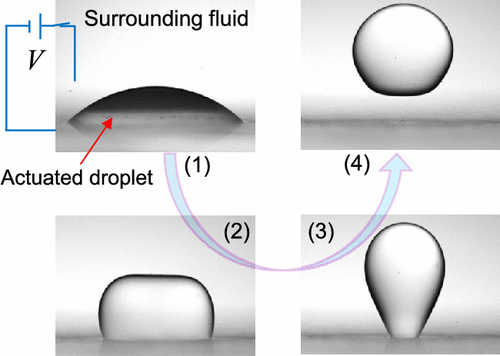Our official English website, www.x-mol.net, welcomes your
feedback! (Note: you will need to create a separate account there.)
Actuation of a Nonconductive Droplet in an Aqueous Fluid by Reversed Electrowetting Effect.
Langmuir ( IF 3.7 ) Pub Date : 2020-06-23 , DOI: 10.1021/acs.langmuir.0c01161 Qinggong Wang 1 , Meng Xu 1, 2 , Chao Wang 1 , Junping Gu 1, 3 , Nan Hu 2 , Junfu Lyu 3 , Wei Yao 1
Langmuir ( IF 3.7 ) Pub Date : 2020-06-23 , DOI: 10.1021/acs.langmuir.0c01161 Qinggong Wang 1 , Meng Xu 1, 2 , Chao Wang 1 , Junping Gu 1, 3 , Nan Hu 2 , Junfu Lyu 3 , Wei Yao 1
Affiliation

|
Manipulation of a conductive droplet by electrowetting has been a popular topic in microfluidics whereby wettability of the droplet on a solid surface is increased by applying a voltage between the conductive droplet and the insulated surface. However, the opposite phenomenon, e.g., decreasing the wettability of a nonconductive droplet and increasing its contact angle (CA) by the reversed electrowetting (REW) effect, has been scarcely reported. Such a process involves not only the transient dynamics of droplet dewetting but also a critical condition for droplet detachment from the adhesive surface. In this work, actuation of a nonconductive droplet in an aqueous surrounding fluid by REW is studied experimentally. Silicone oil is used for the actuated droplet, and filtered water is used as the surrounding fluid. The solid substrate is made of a glass substrate coated with an indium tin oxide (ITO) film and then deposited by a dielectric layer of Parylene C. Potential difference is applied between the substrate and the surrounding fluid, eliminating the disturbance from the top needle on the motion of the droplet. Three different regimes are identified in the full range of operation. An underactuated regime occurs at low applied voltages, in which the CA of the droplet shows a monotonic increase with the increase of voltage (V). The friction coefficient of the contact line decreases with V before the CA saturation (Vs) but shows little change when V > Vs. At high voltages, the contact line of the sessile droplet is contracted excessively by REW. The droplet shows oscillation, and it refers to the overactuated regime. A combined time scale is proposed, and it verifies that the viscous dissipation of the contact line and liquid inertia show comparable contributions in the droplet dynamics. At sufficiently high voltages, the droplet is rejected completely from the surface. A critical equation for the threshold voltage of droplet detachment is built, and its validity is confirmed by experimental results.
中文翻译:

通过反向电润湿效应驱动水性流体中的非导电液滴。
通过电润湿来操纵导电液滴已成为微流体领域的热门话题,其中通过在导电液滴和绝缘表面之间施加电压来提高液滴在固体表面上的润湿性。然而,几乎没有报道相反的现象,例如通过反向电润湿(REW)效应降低非导电性液滴的润湿性并增加其接触角(CA)。这样的过程不仅涉及液滴去湿的瞬态动力学,还涉及液滴从粘合剂表面脱离的临界条件。在这项工作中,通过REW实验研究了水性周围流体中非导电液滴的驱动。硅油用于驱动液滴,过滤水用作周围流体。固态基板由玻璃基板制成,该玻璃基板上涂有氧化铟锡(ITO)膜,然后通过聚对二甲苯C的介电层进行沉积。在基板和周围的流体之间施加了电势差,从而消除了顶部针对仪器的干扰。液滴的运动。在整个操作范围内确定了三种不同的方案。在较低的施加电压下会发生欠驱动状态,其中液滴的CA随电压的增加显示单调增加(在整个操作范围内确定了三种不同的方案。在较低的施加电压下会发生欠驱动状态,其中液滴的CA随电压的增加显示单调增加(在整个操作范围内确定了三种不同的方案。在较低的施加电压下会发生欠驱动状态,其中液滴的CA随电压的增加显示单调增加(V)。接触线的摩擦系数在CA饱和前随V减小(V s),但当V > V s时变化很小。在高电压下,无固小滴的接触线会因REW过度收缩。液滴显示出振荡,它表示过度激活状态。提出了一个组合的时间尺度,它验证了接触线的粘性耗散和液体惯性在液滴动力学中显示出可比的贡献。在足够高的电压下,液滴会从表面完全排出。建立了液滴分离阈值电压的临界方程,并通过实验结果验证了其有效性。
更新日期:2020-07-21
中文翻译:

通过反向电润湿效应驱动水性流体中的非导电液滴。
通过电润湿来操纵导电液滴已成为微流体领域的热门话题,其中通过在导电液滴和绝缘表面之间施加电压来提高液滴在固体表面上的润湿性。然而,几乎没有报道相反的现象,例如通过反向电润湿(REW)效应降低非导电性液滴的润湿性并增加其接触角(CA)。这样的过程不仅涉及液滴去湿的瞬态动力学,还涉及液滴从粘合剂表面脱离的临界条件。在这项工作中,通过REW实验研究了水性周围流体中非导电液滴的驱动。硅油用于驱动液滴,过滤水用作周围流体。固态基板由玻璃基板制成,该玻璃基板上涂有氧化铟锡(ITO)膜,然后通过聚对二甲苯C的介电层进行沉积。在基板和周围的流体之间施加了电势差,从而消除了顶部针对仪器的干扰。液滴的运动。在整个操作范围内确定了三种不同的方案。在较低的施加电压下会发生欠驱动状态,其中液滴的CA随电压的增加显示单调增加(在整个操作范围内确定了三种不同的方案。在较低的施加电压下会发生欠驱动状态,其中液滴的CA随电压的增加显示单调增加(在整个操作范围内确定了三种不同的方案。在较低的施加电压下会发生欠驱动状态,其中液滴的CA随电压的增加显示单调增加(V)。接触线的摩擦系数在CA饱和前随V减小(V s),但当V > V s时变化很小。在高电压下,无固小滴的接触线会因REW过度收缩。液滴显示出振荡,它表示过度激活状态。提出了一个组合的时间尺度,它验证了接触线的粘性耗散和液体惯性在液滴动力学中显示出可比的贡献。在足够高的电压下,液滴会从表面完全排出。建立了液滴分离阈值电压的临界方程,并通过实验结果验证了其有效性。











































 京公网安备 11010802027423号
京公网安备 11010802027423号